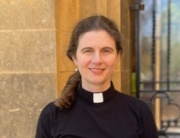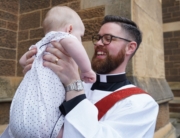St Peter’s Day, 1st July 2018
The Very Rev’d Frank Nelson
Ezekiel 2: 1 – 7
Psalm 34: 1 – 10
Acts 12: 1 – 11
Matthew 16: 13 – 19
From fisherman to keeper of the keys – not a bad start to one’s resume when applying for a job. The many stories of Peter found in the Gospels and Acts are well known in this Cathedral. He is, after all, our patron saint and always has been, ever since Bishop Augustus Short laid the foundation stone not far from where I am standing now on St Peter’s Day, 29th June 1869. If you haven’t already done it, the maths says that is 149 years ago. Just a fraction of the age of another St Peter’s Church, better known as Westminster Abbey, that was so important in Short’s life. Nor does our St Peter’s have the distinction of being the venue for the coronation of every English and British monarch since William the Conqueror way back in 1066! It does have the distinction of being our place, our sacred space where, for very nearly one hundred and fifty years people have come to worship God, to say their prayers and confess their sins. It has been, and continues to be, a place of pilgrimage – the crocodile of girls from St Peter’s Girls under the watchful eye of the sisters; the great youth pilgrimages of the 1950s which some of you were part of; the destination on Christmas Eve for the lively and loud Sudanese Anglican community, led by flags, drummers and dancers; a place where people come, alone or in twos and threes.
According to the Gospels it all began when an unknown itinerant preacher-man called four men to leave their nets at the Sea of Galilee and follow him. Simon, as he was named by his parents, was one of them, later to be named Peter – the Rock. In this Cathedral are windows and carvings and stories about Peter – his denial and the crowing cock, the restoration and command to feed the sheep, the crossed keys and upside down cross – reminders of Jesus’s words in today’s Gospel reading and the legend that tells of Peter’s own crucifixion and request to be nailed upside down on his cross.
Peter plays a leading role in the early church. He it is who becomes the spokesperson for the Apostles on the Day of Pentecost, explaining to the bewildered crowd gathered to see what all the noise and commotion was all about, that they were not drunk but filled with God’s Spirit. In the early chapters of Acts Peter preaches the Gospel, heals the sick and, as we heard this morning, gets arrested and is miraculously released. To Peter is given a special vision that would change the nature of the fledgling gathering of Jewish people who believed Jesus was the long-awaited Messiah. A lunch-time vision of a sail-cloth filled with all sorts of living creatures and a voice commanding Peter to kill and eat – despite the strict culinary rules around what was clean and unclean – led Peter to open the church to all people – both Jew and Gentile.
That openness is something we treasure today and is included in the tagline at the foot of the front page of every service booklet we produce. It’s a bold claim and one that constantly fascinates, disturbs and challenges me – as I hope it does you. “St Peter’s Cathedral strives to be a Christ-centred, sacramental, inclusive, thinking, mission-oriented, faith community.” It’s particularly challenging when, as happens, we find there are restrictions on who may or may not do something in the Cathedral, or who in practice we actually welcome, or who is missing from our number. Be that as it may, the tagline is printed there for us to see, to notice, to continue working towards.
In my experience just when we think we are doing pretty well in one area, the finger of God is moved to another spot which calls for our attention. It’s as if God says, “OK – so you are beginning to sort that area of your lives out, now what about this one.” The history of this cathedral, even over its relatively short life-span, has seen challenges and changes come about. When I first came here I was told by some that the Cathedral is for Adelaide’s elite! Yet when I read the history I find that things are a little different. Adelaide church historian David Hilliard has this to say about St Peter’s Cathedral: “St Peter’s Cathedral was intended to be a church for all classes of society. There were no rented pews, so that all seats were ‘free’, available to casual attenders.” (David Hilliard, Godliness and Good Order, pg 41) My own observation is that we are a glorious mix of God’s people, each and every one loved and precious in the sight of God.
Each generation brings its own challenges and opportunities for change. It was not until 1894 that vestments were first introduced to the Cathedral, well before anyone dared to use incense during a service. Nowadays we rejoice in the ministry of women clergy – forgetting that it is well within the life-span of most here today that the first women were ordained priest in this Cathedral on December 5th, 1992. The now deceased Ken Hampton was the first Aboriginal person to be ordained in the Cathedral in 1986, followed a few years later by Chris McLeod. As you know he was consecrated bishop just a year or two ago – in St Peter’s Cathedral. Who knows what the issues will be that await just around the corner that will need the focused attention of God’s people in this place as we continue to strive to be a Christ-centred, sacramental, inclusive, thinking, mission-oriented, faith community.
Peter was called at the lakeside to follow Jesus. At the end of John’s Gospel he is charged to feed God’s sheep. In today’s Gospel reading from Matthew 16 Jesus says Peter is to be the rock – not just any rock, but the rock on which the church is built. And there’s more, for to Peter is given the keys to the kingdom of heaven, and the authority to bind and let loose. Quite what that means is open to interpretation – but we can be sure Jesus would not have meant that Peter could lord it over his fellow disciples and the rest of the believers. Sadly, perhaps because the church is made up of ordinary human beings like you and me, all too often the Lordship of Christ has been supplanted by the lording of those who think they are more important than they are – with disastrous consequences.
Today is a time to give thanks – give thanks for St Peter, with all his strengths and weaknesses, his failures and triumphs; to give thanks to God for the gift of Jesus Christ, a gift given in incredible love and at an unimaginable cost. It is a day to recall the opening words of Psalm 34 and determine again to bless the Lord at all times. It is a day to give thanks for past benefactors – those whose generosity of spirit and wallet left us an inheritance this sacred place. It is a day on which we celebrate the past and imagine the future. It is a day of prayer – of thanksgiving for God’s great gifts, of repentance for our failings, of intercession for the world, our city, communities, churches, families and friends. It is a day of recommitment, of rededication, to the one who called Peter to follow, and continues to call us to follow. It is a day to step out boldly into the future – walking in the steps of Our Lord, seeking at all times to love God and love our neighbour.
Today is St Peter’s Day – thanks be to God.





